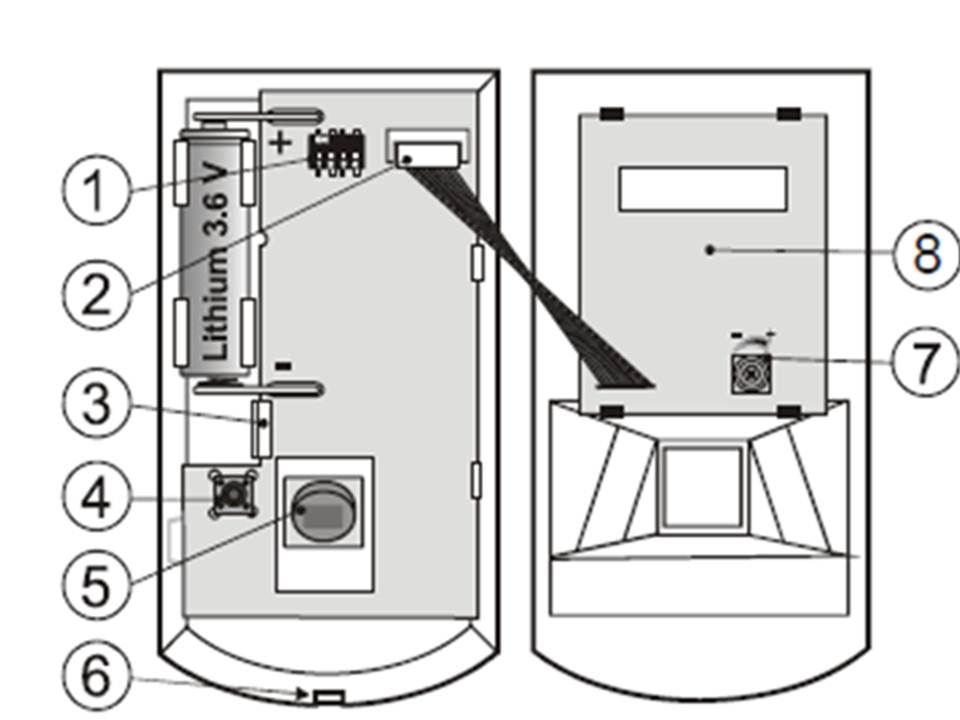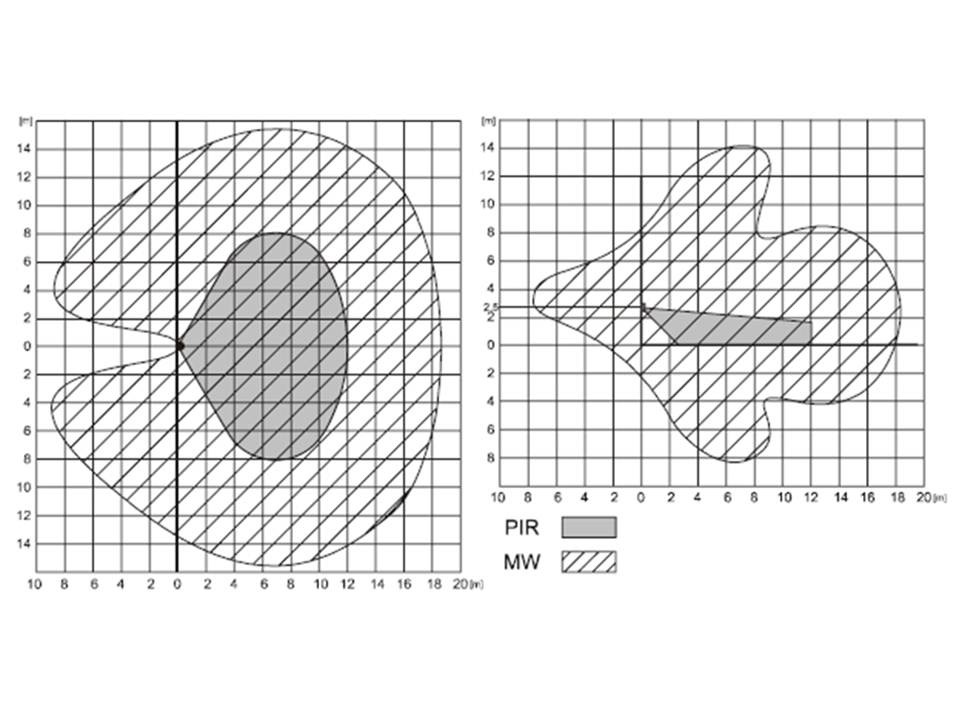JA-80W
There are no products in these categories. Shop on.

Service instructions for JA-80W
1 Installation
The installation must be carried out only by installers who have a certificate issued by an authorised distributor. No obstacles must obstruct the view of the P.I.R. detector protecting the area. Keep the detector away from metal objects that can interfere with radio communication and the microwave area.

Description: 1. DIP switch; 2. Microwave part connector; 3 PCB tab; 4. Sabotage switch; 5. P.I.R. sensor; 6. Front cover tab; 7. Microwave sensitivity setting; 8. Microwave detector
1. Open the cover of the detector by pressing the tab (6) and remove the PCB
PCB which is in an internal tab (3) Avoid touching the internal P.I.R.
or damaging the antenna.
2. Turn screw holes through the rear plastic cap according to the installation point, either for a
corner or for a wall. At least one screw should penetrate the tamper
sensitive point.
3. Screw the back cover to the wall, about 2.5 metres above the floor (vertically, with the
tab down).
4. Returning the PCB to its original position until the tab (3) clicks.
5. Leave the battery disconnected and the cover open and follow the control panel or the
receiver manual.
- Enter learning mode on the control panel by keying in "1" in service mode.
- Install a battery in the detector to activate enrollment.
- Exit enrollment by pressing "#"
6. Close the detector cover until the tab clicks. The supplied screw can be safely
attached to the tab.
7. After installing a battery in the detector, it takes only three minutes to
stabilise. During this period, the LED lights up continuously.
Notes:
Enrolling a detector after already having a battery connected, first disconnect the battery and press the tamper switch and release the tamper switch again to switch to discharge for any remaining voltage for the device ready for enrollment.
The detector can also be enrolled by entering the serial number - The last 8 numbers of the barcode. To observe EN 50131-2-4 the tab must be secured by the screw provided.
2 Environment DIP switch
Switch No 1: DEL / INS: OFF (DEL) provides input and output delays for detectors installed in a building entrance. The ON (INS) activates the detector immediately when the central unit is switched on. DIP switch No 1 only has an effect when the detector gives a natural response it has in the OASIS central unit. It also has no effect when used with a UC-8x or AC-8x receiver.
Switch No. 2: P.I.R. NORM / HIGH selection of false alarm immunity. The OFF (NORM) position combines very well with fast immunity sensor responses. The ON (HIGH) position gives increased immunity with a slower response time and is used only for the problematic installations.
Switch No. 3: Microwave NORM / HIGH sets the period after P.I.R. detection which activates the microwave detection. The position OFF - 1 sec, ON - 2 sec.
Switch No. 4: Microwave NORM / TEST the position OFF is for the standard function of the detector. The Microwave detection is controlled by the P.I.R. detection part for one or two seconds to switch to #3. The position ON - Microwave detection operates continuously for test purposes (walk test).
3 Testing the detector
15 minutes after closing the detector, the LED indicators indicate that the detector has been activated. A short flash of the red light gives the P.I.R. detection confirmation of movement and a long flash (2 sec) gives the Microwave detection confirmation of movement. For the proper operation of the detector, it is essential to set the Microwave detection field to the place to be protected. For setting, switch the fourth DIP switch to the trial position. Sensitivity (monitoring range) can be set by a potentiometer on a part of the Microwave detection located in the front of the detector. Turning to the right increases the sensitivity (range). Prevent the selection from having too high a sensitivity, if the detection concerns, for example, the surrounding rooms. In general, the Microwave detection field should be the same as that of the P.I.R. detection. After setting, return the DIP switch to the NORM position. To save energy on the battery, part of the P.I.R. sensor detector switches to energy-saving mode 15 minutes after closing coverage. As long as the P.I.R. sensor is in energy-saving mode, it still watches for movement. The first movement is detected and confirmed by the Microwave section and is then immediately signalled in the control centre. For the next 5 minutes, the P.I.R. sensor ignores all further movements. After these 5 minutes, the P.I.R. sensor then returns to look out for movements until it is reactivated.
4 Replacing the battery
This detector has two batteries inside that are checked regularly. If one of the batteries has expired, the user or installer will be notified. The detector continues to operate and any movement at the front of the detector is indicated by a short LED flash. Batteries should be replaced within two weeks by a qualified installer. After replacing the battery, test the operation of both sensors.
5 Removing the detector from the system
If a detector has been removed, the control centre will announce the removal. The detector must be unregistered from the configuration screen in the control panel before it is actually removed.
6 Detection features

7 Technical parameters
| Voeding: | Lithium battery type (power source type C) |
| Typical battery life: | approx. 2 years |
| Communicatie-band: | 868 MHz, OASIS Protocol |
| Mededeling: | approx. 300m (open space) |
| Aanbevolen montagehoogte: | 2.0 to 2.5m above floor level |
| PIR detection angle/detection range: | 110° / 12m (with a base lens) |
| MW detection range / frequency: | 0.5 to 20m / 9.35 GHz |
| Operational environment according to EN-50131-1: | 2 indoor general |
| Operational temperature range: | -10 to +40 °C |
| Afmetingen: | 110 x 60 x 55 mm |
| EN 50131-1, EN 50131-6, EN 50131-5-3 classification: | class 2 |
| Can be operated according to: | ERC REC 70-03 |
Complies with ETSI EN 300220, ETSI EN 300 440-1, EN 50130-4, EN 55022, EN 60950-1
